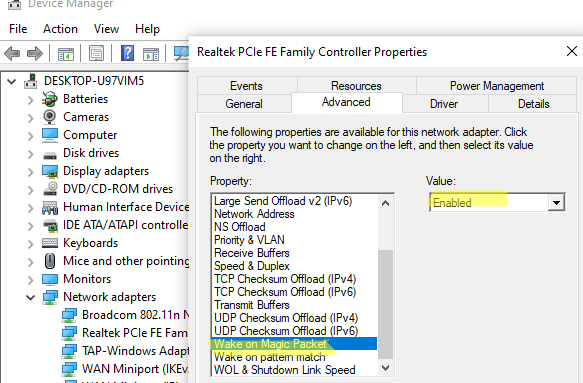Технология Wake on LAN (WoL) используется для удалённого пробуждения (включения) компьютера, который находится в спящем режиме (режиме пониженного энергопотребления). Сетевая карта компьютера инициирует процесс пробуждения компьютера после получение специального широковещательного пакета (magic packet) со своим MAC адресом. В этой статье мы рассмотрим, как настроить Wake on LAN на компьютере под управлением Windows.
В первую очередь нужно включить функцию Wake-on-LAN в настройках BIOS/UEFI компьютера. В зависимости от модели компьютера и версии прошивки название этой опции может отличаться. Она может называться:
- WOL (Wake-on-LAN)
- Power On By PCI-E
- Resume by PCI-E Device
- Resume by PME
- S4/S5 Wake on LAN
- ErP
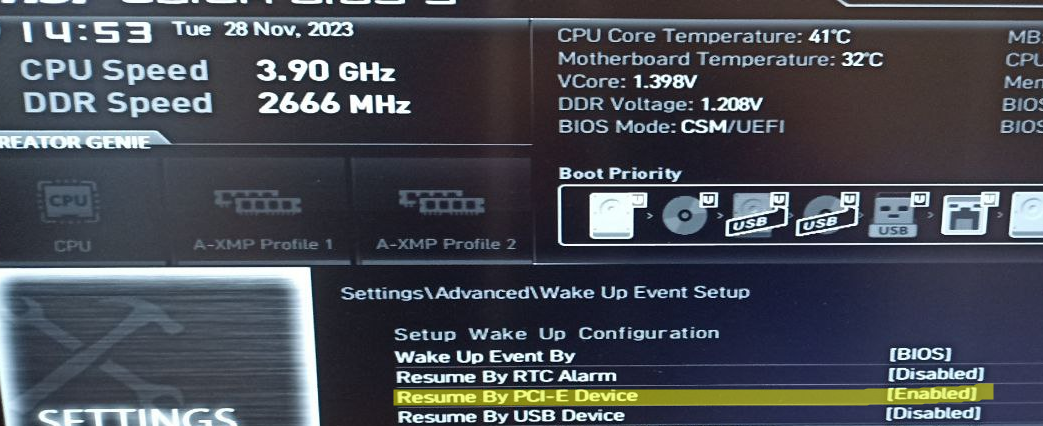
На брендовых моделях компьютеров вы можете вывести и изменить настройки BIOS/UEFI с помощью PowerShell. Например, на ноутбуке Lenovo можно включить опцию WOL в BIOS командами:
$getLenovoBIOS = gwmi -class Lenovo_SetBiosSetting -namespace root\wmi
$getLenovoBIOS.SetBiosSetting("WakeOnLAN,Enable")
$SaveLenovoBIOS = (gwmi -class Lenovo_SaveBiosSettings -namespace root\wmi)
$SaveLenovoBIOS.SaveBiosSettings()
Затем нужно разрешить Wake on LAN (WOL) в настройках сетевого адаптера в Windows.
- Откройте диспетчер устройств (
devmgmt.msc
); - Разверните секцию Network Adapters и откройте свойства вашего физического сетевого адаптера;
- Перейдите на вкладку Advanced и проверьте, что опция Wake on magic packet включена (название может отличаться в зависимости от сетевой карты). В сетевых картах Intel эта опция может называться PME (Power Management Event);
. Можно с помощью PowerShell проверить, включены ли опции WakeOnLan в настройках сетевого адаптера:
Get-NetAdapter -Physical | Get-NetAdapterAdvancedProperty | where {($_.DisplayName -like '*WOL*') -or ($_.DisplayName -like '*Wake*')}Чтобы включить WOL с помощью PowerShell в настройках сетевого адаптера, можно использовать такую команду (зависит от драйвера и венднодоа NIC):
Get-NetAdapter -Physical | Set-NetAdapterPowerManagement -WakeOnMagicPacket Enabled -WakeOnPattern Enabled - Затем перейдите на вкладку Advanced и разрешите сетевой карте выводить компьютер из спящего режима. Включите опции Allow this device to wake the computer и Only allow a magic packet to wake the computer.
Можно включить эту опцию с помощью команды:
powercfg /deviceenablewake "Realtek PCIe GbE Family Controller"
Беспроводные Wi-Fi адаптеры также поддерживают удаленное включение. Этот стандарт называется Wake on Wireless LAN (WoWLAN).
С помощью следующей команды можно проверить, каким устройствам разрешено будить компьютер:
powercfg /devicequery wake_armed

В данном случае видно, что сетевой карте Realtek PCIe разрешено выводить компьютер из спящего режима.
Для работы Wake-on-LAN не нужно открывать дополнительный порты в Windows Defender Firewall. Широковещательный UDP пакет WOL (Magic Packet) принимается и обрабатывается непосредственно сетевой картой и не доходит до сетевого стека Windows.
Теперь, вы можете отправить WoL пакет для удаленного включения компьютера с другого устройства в той же локальной сети. Magic Packet содержит аппаратный адрес сетевой карты (MAC адрес), компьютера который нужно включить. Вы можете узнать MAC адрес сетевой карты компьютера из команды
ipconfig /all
или получить его с помощью PowerShell:
Get-NetAdapter -Physical

Вы можете сформировать и отправить широковещательный magic пакет WOL с помощью PowerShell. Укажите MAC адрес устройства, которое нужно включить в следующем скрипте и выполните его:
$Mac = "08:9e:01:6b:52:a2"
$MacByteArray = $Mac -split "[:-]" | ForEach-Object { [Byte] "0x$_"}
[Byte[]] $MagicPacket = (,0xFF * 6) + ($MacByteArray * 16)
$UdpClient = New-Object System.Net.Sockets.UdpClient
$UdpClient.Connect(([System.Net.IPAddress]::Broadcast),7)
$UdpClient.Send($MagicPacket,$MagicPacket.Length)
$UdpClient.Close()

Если вы все настроили правильно, удаленный компьютер должен проснуться.
Для работы WOL в сегментированных сетях или разделенных на VLAN, нужно включать пересылку широковещательных WoL пакетов (
UDP порт 9
) на уровне коммутаторов/маршрутизаторов.
Для удаленного пробуждения компьютеров можно использовать бесплатную Windows утилиту от NirSoft WakeMeOnLan. Утилита позволяет автоматически просканировать LAN и найти все доступные устройства, или вы можете вручную добавить устройства, которые вы хотите включать удаленно через WakeOnLan.
Утилита поддерживает режим работы из командной строки. Чтобы включить компьютер, нужно выполнить команду (утилита отрезолвит IP адрес в MAC по arp таблице):
WakeMeOnLan.exe /wakeup 192.168.31.15
Или по MAC адресу:
WakeMeOnLan.exe /wakeup 08-9E-01-6B-52-A2
Также можно использовать утилиты для смартфонов. Например, Wake On LAN для Android (для удаленного включения компьютера вы должны быть подключены к той же LAN через Wi-Fi точку доступа).
Если компьютер не включается после отправки пакета Wake-on-LAN, возможно нужно LAN нужно отключить быстрый запуск Windows в настройках электропитания (на моих двух тестируемых устройствах с Windows 10 и 11 это не понадобилось). Fast Startup включен по-умолчанию в Windows 10 и 11 и может препятствовать пробуждению компьютера через WOL (или вызывать ситуацию, когда компьютер не выключается после завершения работы Windows).
Откройте панель
powercfg.cpl
-> Choose what the power buttons do -> Change settings that are currently unavailable -> отключите опцию Turn on fast startup (recommended).
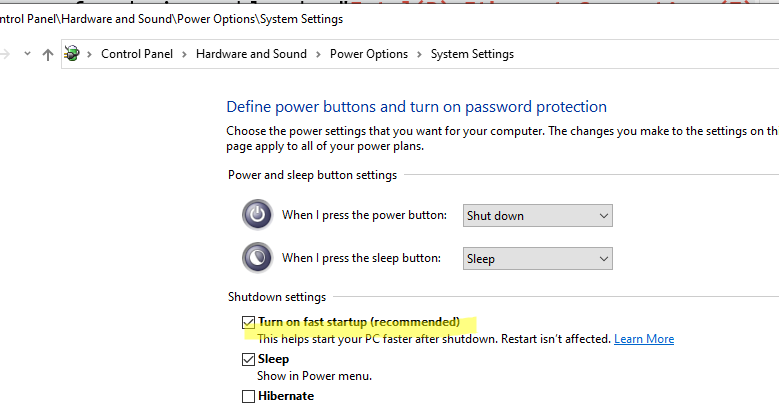

On Windows 11, Wake on LAN (WoL) is a networking feature that lets you turn on a computer remotely from a low-power state. It works by sending a special «magic packet» over the network, but it’s only available on compatible hardware.
WoL has been around for years. While not essential for everyone, it’s incredibly useful in many scenarios. For example, you can power on a remote computer to retrieve files, run backups, or perform maintenance (without keeping it on 24/7 and wasting energy).
If your hardware supports it, you can enable WoL through your motherboard settings or an add-in network card’s firmware. Once enabled, you’ll need a third-party app or script to send the signal and wake the computer remotely.
In this how-to guide, I’ll walk you through the steps to enable WoL on your computer.
Recent updates
These instructions has been updated to ensure accuracy and reflect changes to the process in the operating system.
How to enable WoL on Windows 11
On Windows 11, to use Wake on LAN, you have to enable the feature on the motherboard’s firmware (UEFI). You can turn it on directly from the Windows settings if you have an add-in card or USB adapter.
Firmware configuration
To enable Wake on LAN on the UEFI firmware, use these steps:
All the latest news, reviews, and guides for Windows and Xbox diehards.
- Open Settings.
- Click on System.
- Click the Recovery page on the right side.
- Click the Restart now button for the «Advanced startup» setting under the «Recovery options» section.

- Click the Restart now button for the «Advanced startup» setting under the «Recovery options» section.
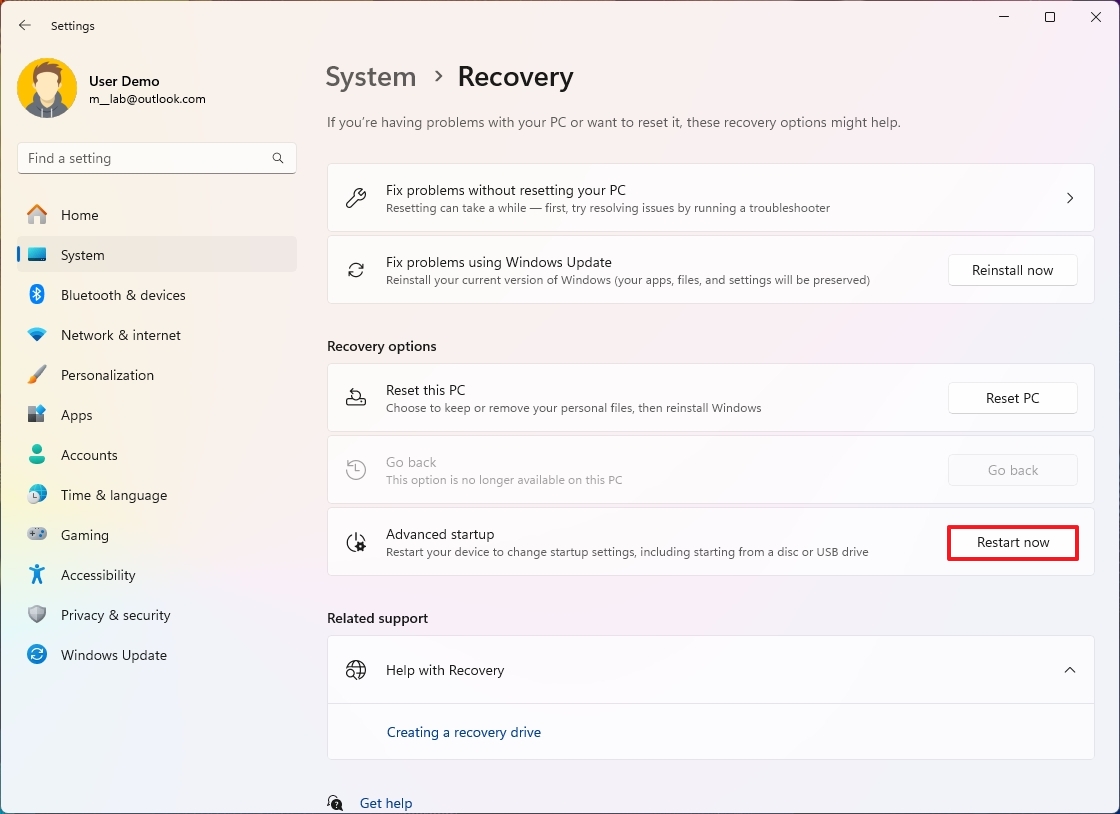
- Click the Restart now button again.
- Click on Troubleshoot.
- Click on Advanced options.
- Click the «UEFI Firmware Settings» option.
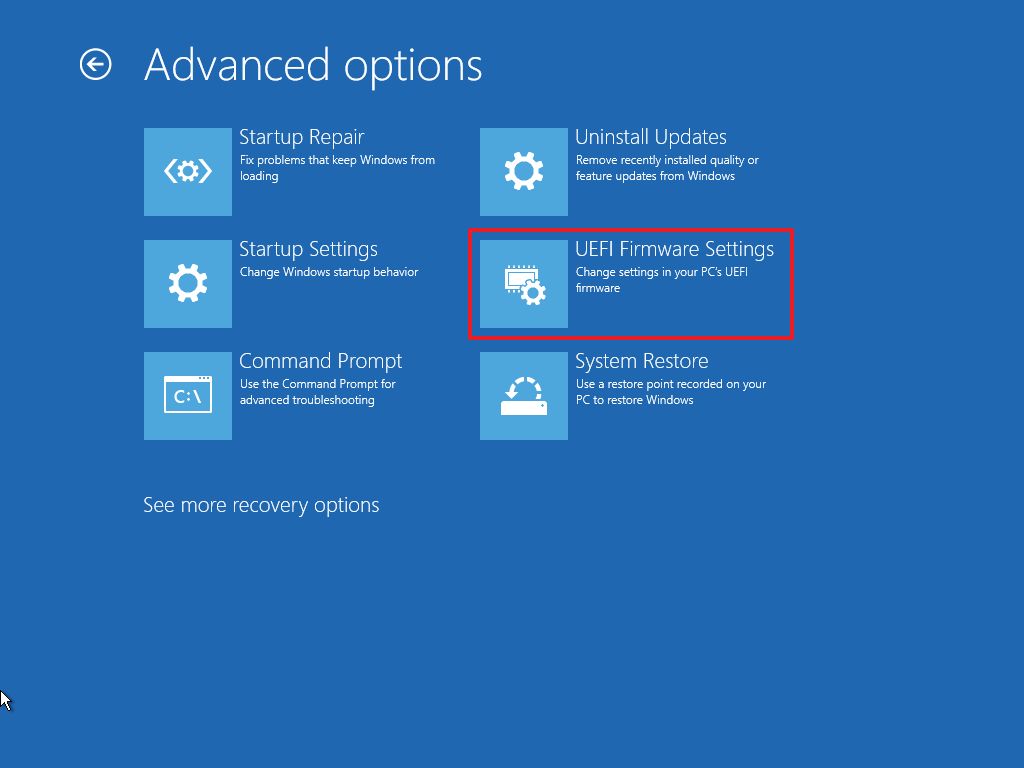
- Click the Restart button.
- Navigate to the power options tab.
- Turn on the Wake on LAN (WoL) feature.
- Quick note: Since the firmware settings can vary per manufacturer and computer model, it’s best to check your manufacturer support website for more specific instructions.
- Save the changes.
- Restart the computer.
Once you complete the steps, you can continue with the instructions to wake up the computer remotely.
Although it may not be necessary, you can also use the steps below to double-check that the feature is ready on Windows 11 to receive magic packets over the network.
Network settings configuration
To enable Wake on LAN from the Settings app for add-in cards and USB network adapters, use these steps:
- Open Settings.
- Click on Network & internet.
- Click the Advanced network settings page on the right side.
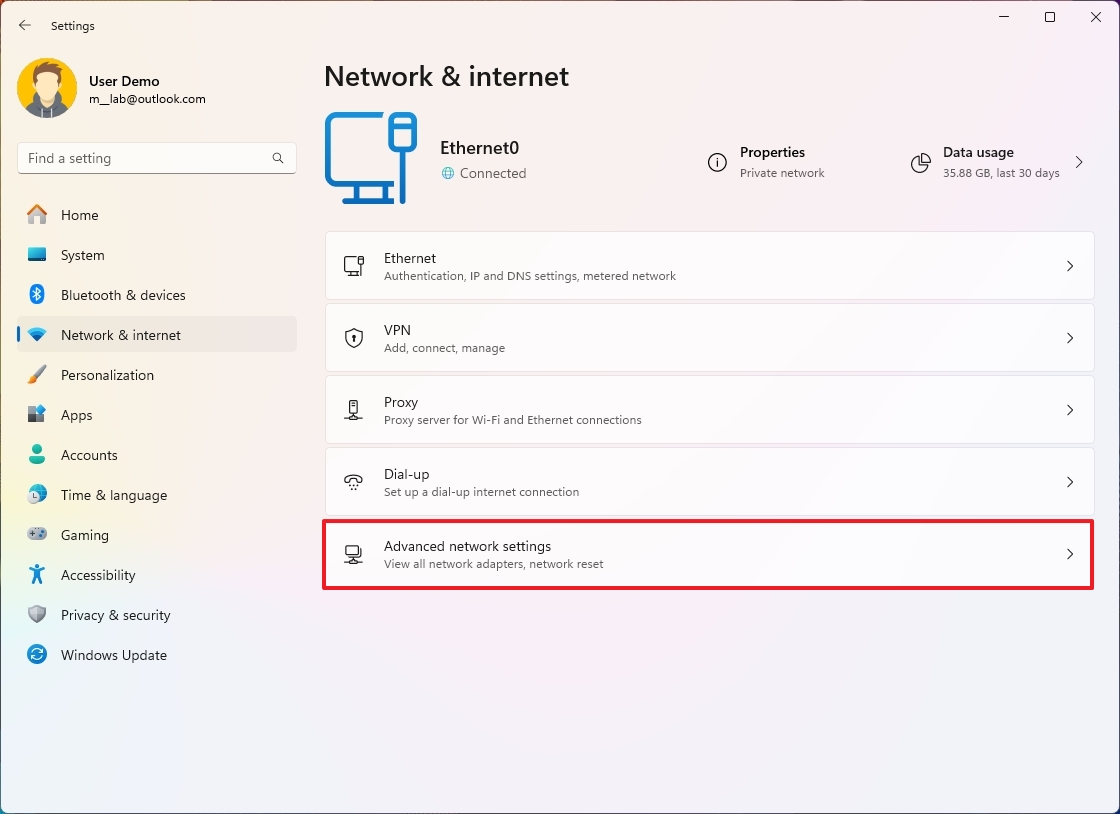
- Click on the network adapter under the «Network adapters» section.
- Click the Edit button in the «More adapter options» setting.
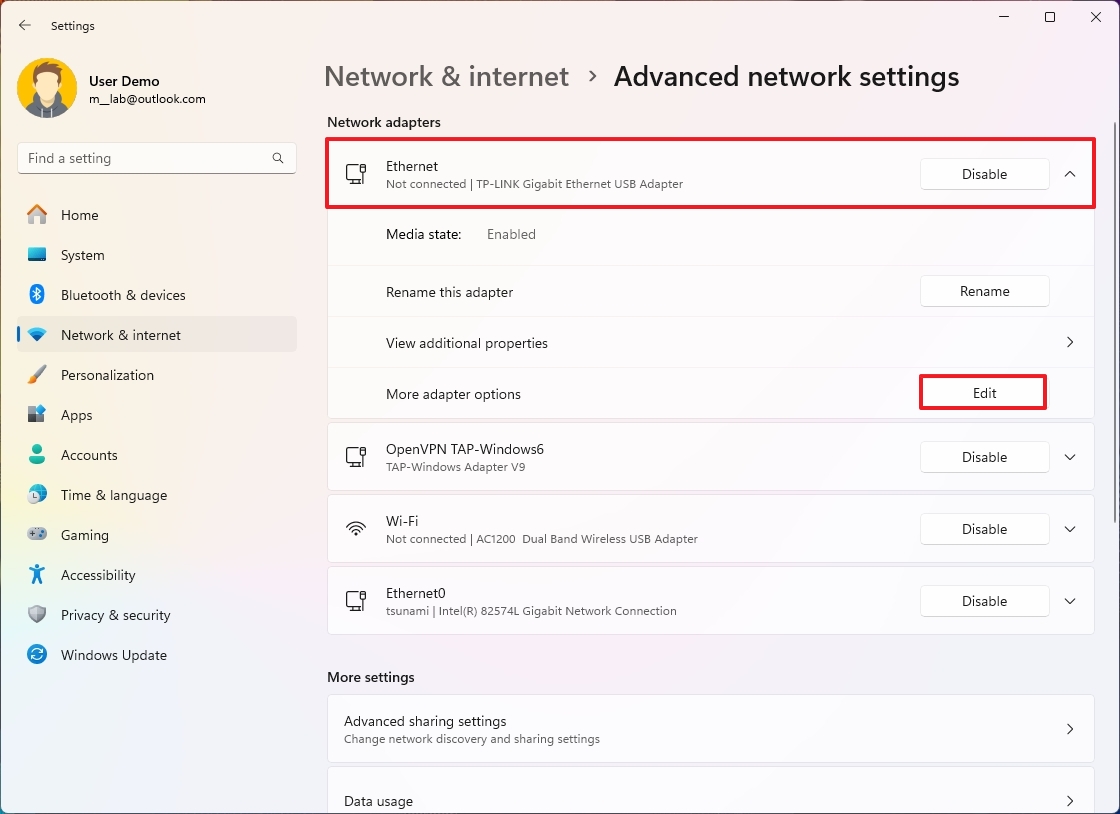
- Click the Configure button.
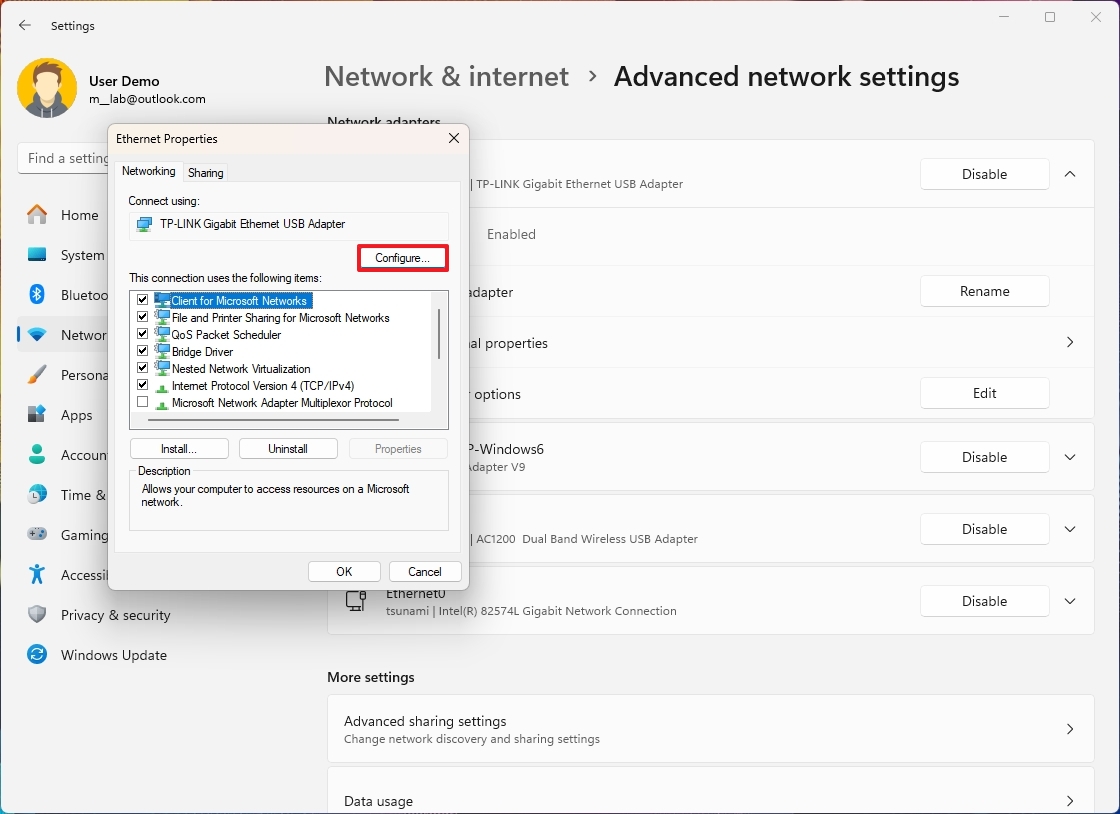
- Click the Advanced tab.
- Select the Wake on LAN setting under the «Properties» section.
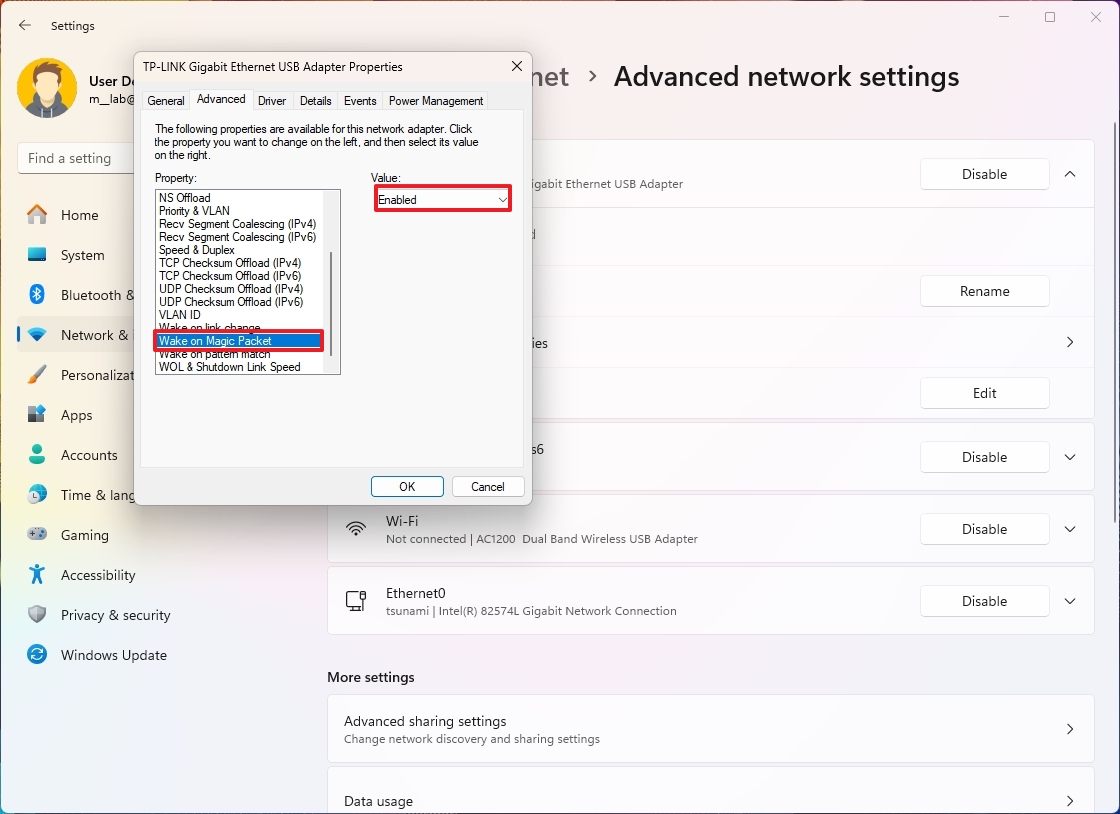
- Quick note: Optional settings may be required if you use a Realtek network adapter.
- Select the Enabled option from the «Value» drop-down menu.
- (Optional) Select the «Wake on pattern match» option.
- Select the Enabled option from the «Value» drop-down menu.
- (Optional) Select the «WoL & Shutdown Link Speed» option.
- Select the 10Mbps option from the «Value» drop-down menu.
- Quick note: The setting could have different names depending on the manufacturer. In this case, the option is called «Wake on Magic Packet.» You may need to check your manufacturer support website for more specific details.
- Click the Power Management tab.
- Check the «Allow the computer to turn off this device to save power» option.
- Check the «Allow this device to wake the computer» option.
- Check the «Only allow a magic packet to wake the computer» option.
- Click the OK button.
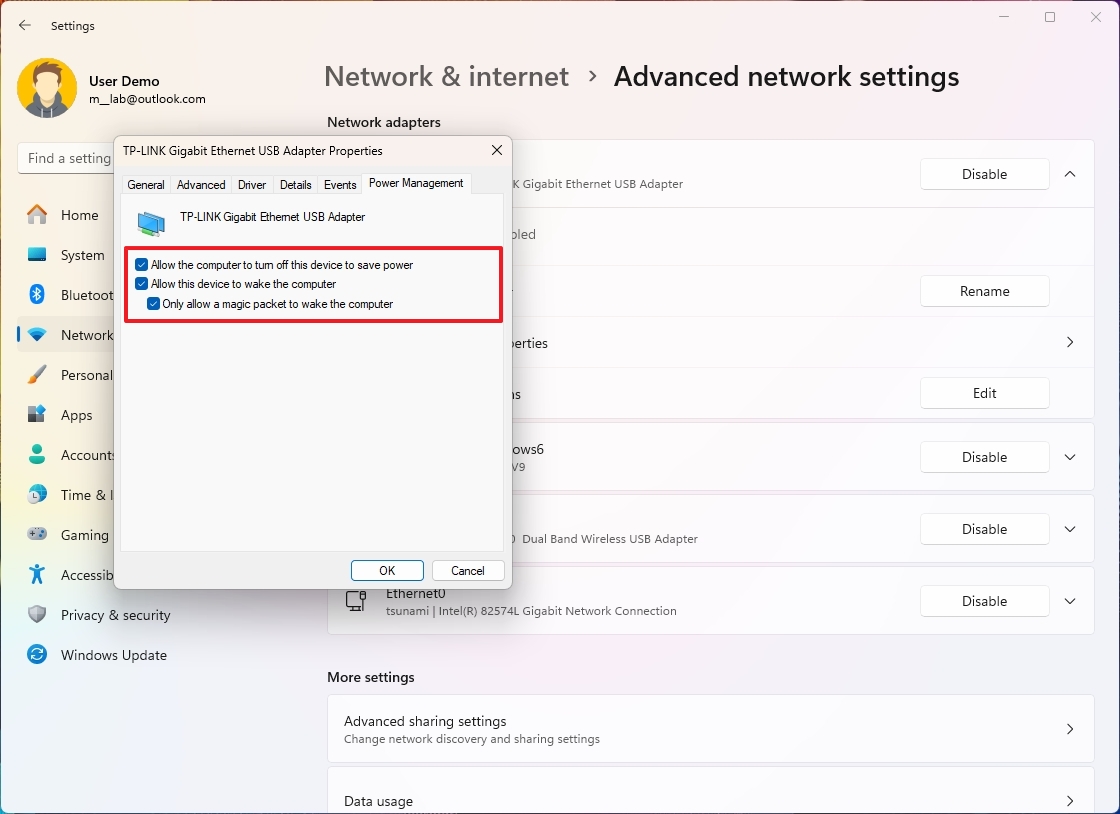
After you complete the steps, you can proceed with the instructions to use a third-party tool or script to send a wake-up packet over the network to the computer you want to start.
You can always disable the WoL feature using the same instructions mentioned above, but in step 9, make sure to disable the option and other settings you may have selected. Also, you may want to disable the feature inside the firmware.
How to send WoL packet on Windows 11
To send a magic wake-up packet, you can use virtually any third-party application for Windows, Linux, or Mac, mobile apps for Android and iPhone, or custom scripts. You may also be able to wake a device through the WoL feature built into the router.
Warning: The app I’m using works as advertised, but it’s a third-party tool, and you should use it only at your own risk. You have been warned.
For this guide, I picked the «WakeMeOnLan» tool from NirSoft to wake a device remotely:
- Open the NirSoft download.
- Click the download option to save the app on your device.
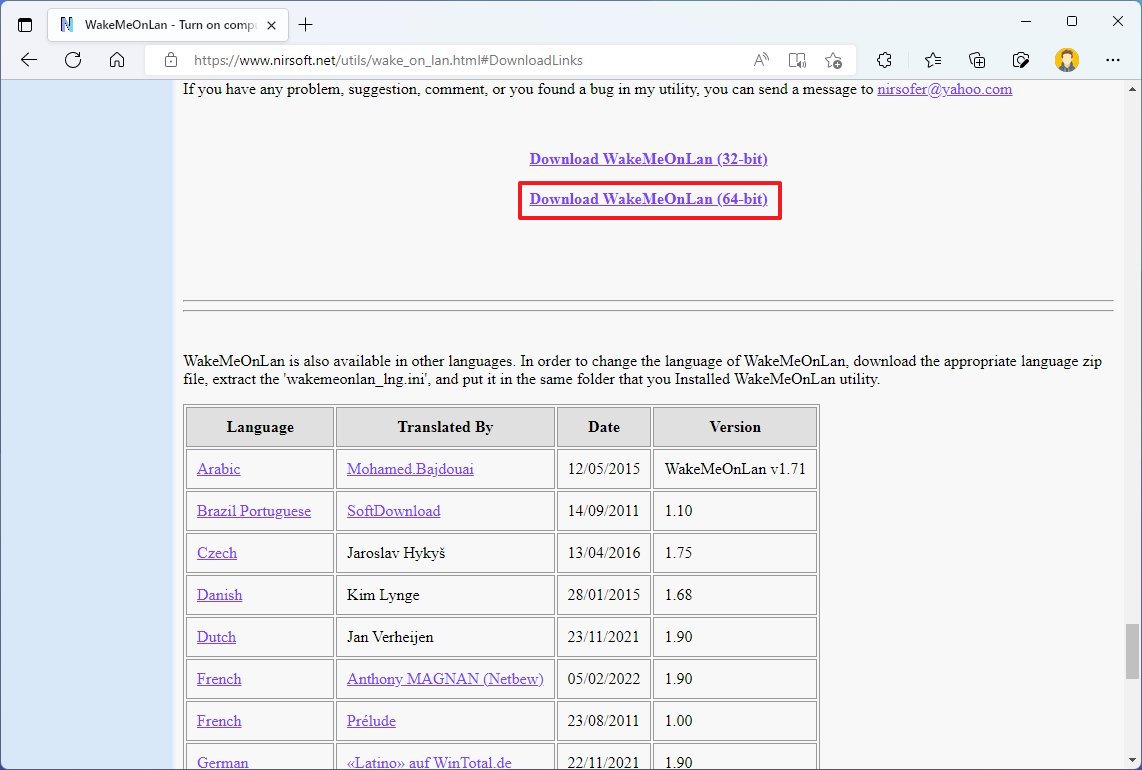
- Right-click the zip folder and select the Extract All option.
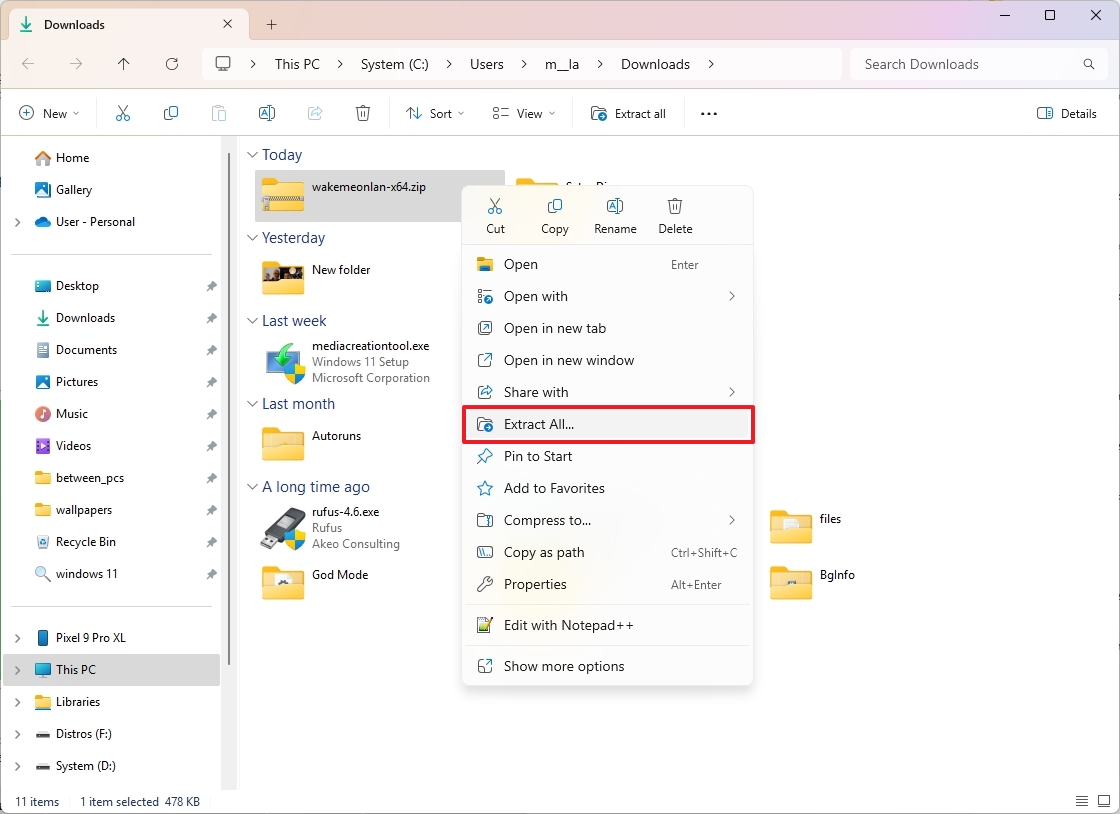
- Click the Extract button.
- Double-click the WakeMeOnLan.exe file to launch the standalone tool.
- Click the Play (Start Scanning) button to discover all the devices in the network.
- Quick note: The device that will wake up remotely must be turned on so the tool can find it. Once it is on the list, the device can be offline to use the WoL feature. You can also use the «Ctrl + N» keyboard shortcut to manually add the remote computer information (IP address, computer name, and MAC address).
- Right-click the remote computer and select the «Wake Up Selected Computers» option.
- Click the Yes button.
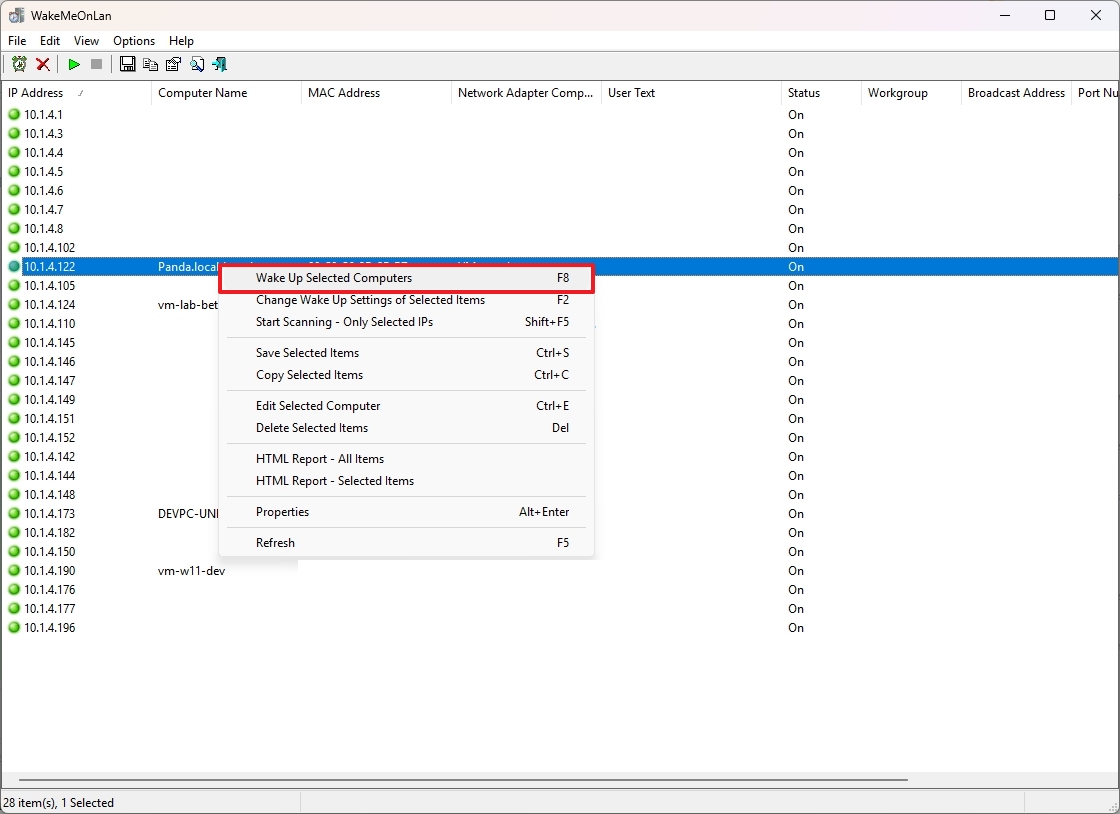
Once you complete the steps, the magic packet will be sent over the network to wake the computer.
Determine network configuration
If you use a tool that offers an interface for entering the device information, you will have to manually obtain the IP and MAC address to use Wake on LAN.
To find the network configuration of your computer, use these steps:
- Open Settings.
- Click on Network & internet.
- Click the «Advanced network settings» page on the right side.

- Click on the network adapter configured for Wake on LAN under the «Network adapters» section.
- Click the «View additional properties» setting.
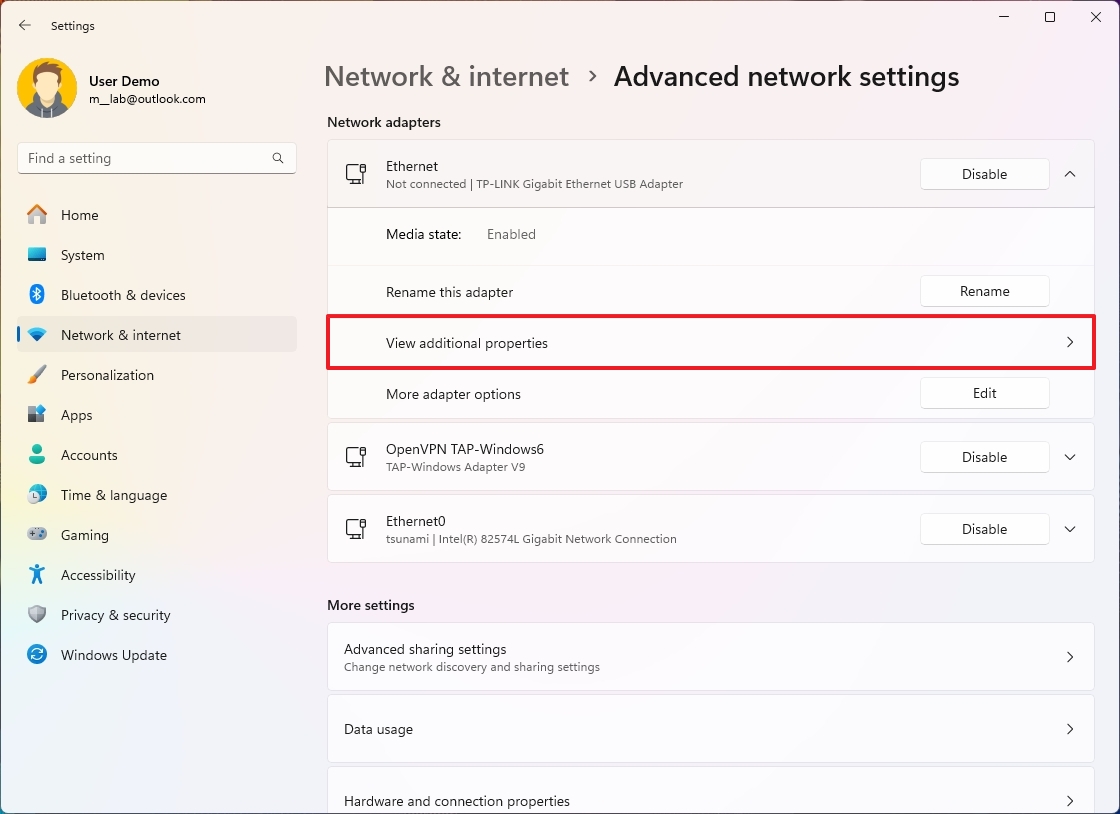
- Confirm the IPv4 address and Physical address (MAC) settings.
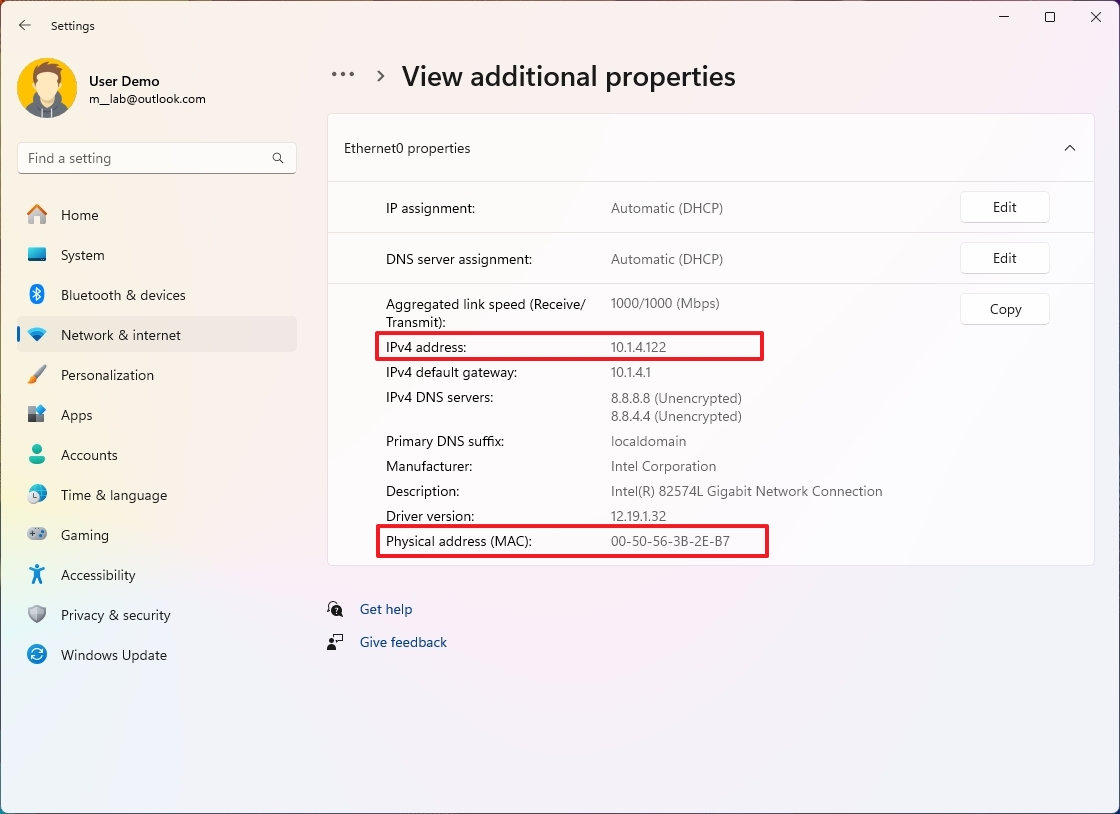
After you complete the steps, use the network addresses to send a magic packet to wake up a device remotely with your particular application.
How to troubleshoot WoL problems on Windows 11
If you sent the Wake on LAN (WoL) command but the computer isn’t turning on, try these troubleshooting steps.
- Using a USB network adapter? WoL may only work when the computer is in sleep mode. When fully powered off, USB ports stop receiving power, preventing the wake signal.
- Missing WoL options? If you don’t see the setting in your motherboard firmware or network adapter properties, your hardware may not support this feature.
- Fast startup enabled? On Windows 11, you may need to disable fast startup to allow WoL to function properly.
- Is the network adapter active? WoL only works if the network adapter remains powered and reachable. If the computer is off, check the Ethernet adapter – blinking lights indicate it’s still active.
- Using a laptop? Ensure it’s plugged into a power source, as some devices disable WoL when running on battery.
- Network issues? If you suspect a connectivity problem, use the «ping» command to test the connection. Also, run «ipconfig» on the target computer to verify the correct IP and MAC address before sending the magic packet.
More resources
For more helpful articles, coverage, and answers to common questions about Windows 10 and Windows 11, visit the following resources:
- Windows 11 on Windows Central — All you need to know
- Windows 10 on Windows Central — All you need to know
Mauro Huculak has been a Windows How-To Expert contributor for WindowsCentral.com for nearly a decade and has over 15 years of experience writing comprehensive guides. He also has an IT background and has achieved different professional certifications from Microsoft, Cisco, VMware, and CompTIA. He has been recognized as a Microsoft MVP for many years.
Enabling Wake on LAN (WoL) on Windows 11 can be a handy feature if you need to remotely power up your computer. Here’s a quick guide to set it up: access your computer’s BIOS, enable the Wake on LAN feature, then configure the setting within Windows Device Manager. This setup allows your computer to be awakened from sleep or powered off state via a network message.
Enabling Wake on LAN Windows 11
Enabling Wake on LAN will allow you to turn on your Windows 11 PC remotely over a network. Follow these steps to get everything configured.
Step 1: Enter BIOS/UEFI settings
Restart your computer and press the key (often F2, F10, F12, Delete) to enter BIOS/UEFI settings.
In most computers, pressing F2 or Delete right after hitting the power button will take you to the BIOS/UEFI menu. Look for on-screen instructions which often flash for a brief moment.
Step 2: Enable Wake on LAN in BIOS/UEFI
Navigate to the Power Management or Advanced menu, then enable the Wake on LAN setting.
Depending on your BIOS/UEFI version, the exact location might differ. Look for options like “Wake on LAN,” “Power On By LAN,” or similar terms. Enable it and save changes before exiting.
Step 3: Boot into Windows 11
Allow your computer to boot normally into Windows 11.
After making changes in BIOS/UEFI, your computer will restart. Let it load Windows 11 fully so you can continue with the next steps.
Step 4: Open Device Manager
Press Win + X and select Device Manager from the menu.
Device Manager is where you manage hardware settings. Accessing it is the next step in configuring WoL in Windows 11.
Step 5: Locate Network Adapter
Find and expand the Network adapters section, then right-click your network adapter and select Properties.
This section lists all network hardware connected to your PC. Identifying your network adapter is crucial for configuring WoL.
Step 6: Enable Wake on LAN
Go to the Power Management tab, check “Allow this device to wake the computer,” and click OK.
Ensuring this option is checked allows the network adapter to receive packets that can wake your computer.
Step 7: Configure Advanced Settings
In the Advanced tab of the network adapter properties, find and enable Magic Packet or Wake on Magic Packet.
Magic Packet is a specific type of network message used to wake the computer. Enabling this ensures compatibility with most WoL software.
Once all these steps are completed, your computer should be able to wake up via a network signal.
Tips for Enabling Wake on LAN Windows 11
- Always ensure your Ethernet cable is plugged in, as WoL generally does not work over WiFi unless specifically supported by your hardware.
- Update your network adapter drivers to the latest version for better compatibility.
- Check your router settings; some routers may need configuration to support WoL.
- Disable fast startup in Windows 11 to avoid conflicts with WoL.
- Test your WoL setup by using a second device and WoL software to send the magic packet.
Frequently Asked Questions about Enabling Wake on LAN Windows 11
What is Wake on LAN?
Wake on LAN (WoL) is a feature that allows a computer to be powered on or awakened from sleep mode remotely using a network message.
Do I need special hardware for Wake on LAN?
Most modern computers and network adapters support Wake on LAN. However, you might need to check if your specific hardware supports it.
Can I use Wake on LAN over WiFi?
WoL typically requires a wired Ethernet connection. Some modern network adapters support WoL over WiFi, but this is less common.
How can I test if Wake on LAN is working?
You can test it by using a second device to send a magic packet using WoL software. If your computer wakes up, it’s working.
What happens if Wake on LAN doesn’t work?
Double-check your BIOS/UEFI settings, network adapter settings in Windows, and ensure your router supports WoL. Updating your drivers may also help.
Summary of Steps
- Enter BIOS/UEFI settings.
- Enable Wake on LAN.
- Boot into Windows 11.
- Open Device Manager.
- Locate Network Adapter.
- Enable Wake on LAN.
- Configure Advanced Settings.
Conclusion
Enabling Wake on LAN on Windows 11 is a practical feature, especially for those who need remote access to their computers. Whether you’re working from another room or across the world, WoL makes it easy to power up your PC remotely.
Following the outlined steps ensures your computer is set up correctly for Wake on LAN, from BIOS/UEFI configuration to Windows Device Manager settings. Don’t forget to test your setup with WoL software to confirm everything is functioning smoothly.
For further reading, consider looking up detailed guides on your specific BIOS/UEFI firmware or consulting community forums for troubleshooting tips. Wake on LAN can become an essential tool in your remote working toolkit, making it easier to manage your computer from anywhere.
Matthew Burleigh has been writing tech tutorials since 2008. His writing has appeared on dozens of different websites and been read over 50 million times.
After receiving his Bachelor’s and Master’s degrees in Computer Science he spent several years working in IT management for small businesses. However, he now works full time writing content online and creating websites.
His main writing topics include iPhones, Microsoft Office, Google Apps, Android, and Photoshop, but he has also written about many other tech topics as well.
Read his full bio here.
Технология Wake-on-LAN (WoL) позволяет удаленно включать компьютер из спящего режима или состояния выключения (S4/S5) с помощью специального широковещательного пакета (Magic Packet), содержащего MAC-адрес сетевой карты. В этой статье мы разберем, как настроить WoL в Windows 10 и Windows 11, включая активацию в BIOS/UEFI, настройку сетевого адаптера, отправку пакетов через PowerShell и использование утилит, таких как WakeMeOnLan.
Приобрести оригинальные ключи активации Windows 11 можно у нас в каталоге от 1690 ₽
Требования для Wake-on-LAN
– Сетевая карта с поддержкой WoL.
– BIOS/UEFI с опцией WoL или аналогичной.
– Компьютер в спящем режиме (S3), режиме гибернации (S4) или выключен (S5, если поддерживается).
– Отправляющее устройство в той же локальной сети (LAN) или с настроенной маршрутизацией Magic Packet.
Шаг 1: Включение WoL в BIOS/UEFI
1. Перезагрузите компьютер и войдите в BIOS/UEFI (обычно клавиши Del, F2 или F10).
2. Найдите опцию, связанную с WoL. Возможные названия:
– Wake-on-LAN (WOL)
– Power On By PCI-E
– Resume by PCI-E Device
– Resume by PME
– S4/S5 Wake on LAN
– ErP (установите в Disabled для поддержки S5).
3. Включите опцию (установите Enable) и сохраните настройки (F10).
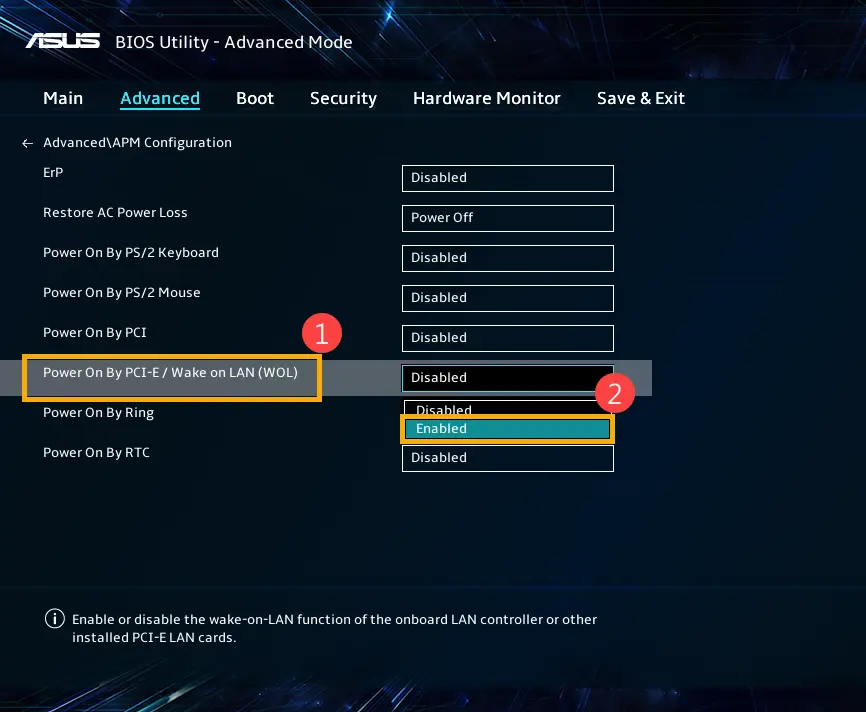
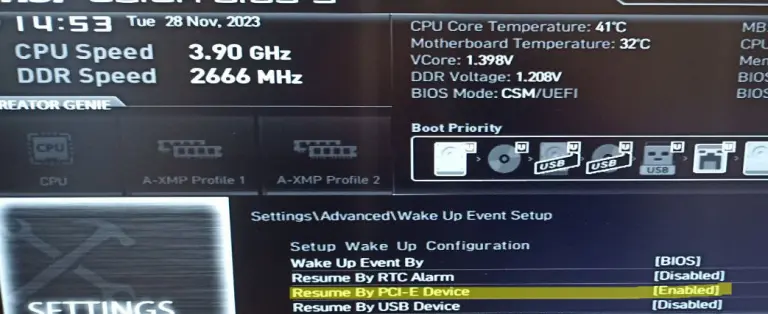
Управление BIOS через PowerShell (Lenovo)
На некоторых устройствах Lenovo можно включить WoL через PowerShell:
$getLenovoBIOS = Get-WmiObject -Class Lenovo_SetBiosSetting -Namespace root\wmi
$getLenovoBIOS.SetBiosSetting("WakeOnLAN,Enable")
$SaveLenovoBIOS = Get-WmiObject -Class Lenovo_SaveBiosSettings -Namespace root\wmi
$SaveLenovoBIOS.SaveBiosSettings()
Шаг 2: Настройка сетевого адаптера в Windows
1. Откройте Диспетчер устройств (Win+R, devmgmt.msc).

2. Разверните раздел Сетевые адаптеры (Network adapters).
3. Щелкните правой кнопкой мыши по физическому адаптеру и выберите Свойства.
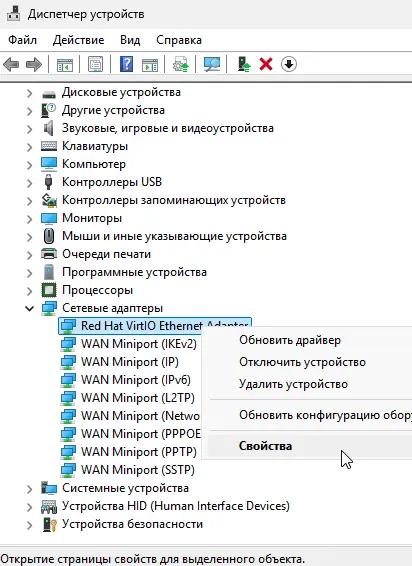
Вкладка Advanced
1. Перейдите на вкладку Дополнительно (Advanced).
2. Найдите опцию, связанную с WoL:
– Wake on Magic Packet
– PME (Power Management Event) (для карт Intel)
– Wake on LAN
3. Установите значение Enabled.
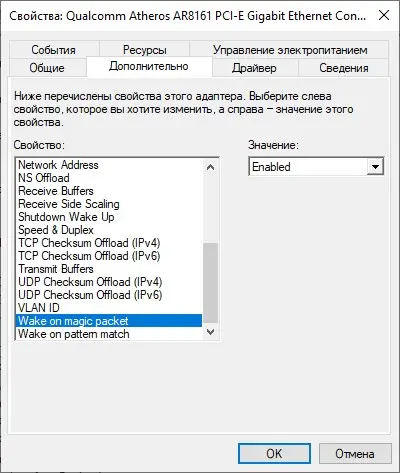
Вкладка Power Management
1. Перейдите на вкладку Управление электропитанием (Power Management).
2. Включите опции:
– Разрешить этому устройству выводить компьютер из ждущего режима (Allow this device to wake the computer).
– Разрешить только «магический пакет» для вывода компьютера из ждущего режима (Only allow a magic packet to wake the computer).
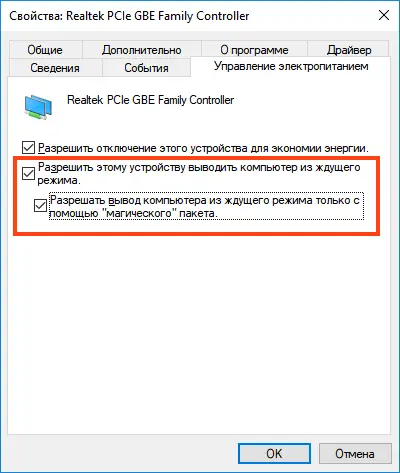
Настройка через PowerShell
Проверьте настройки WoL:
Get-NetAdapter -Physical | Get-NetAdapterAdvancedProperty | Where-Object {($_.DisplayName -like '*WOL*') -or ($_.DisplayName -like '*Wake*')}

Включите WoL:
Get-NetAdapter -Physical | Set-NetAdapterPowerManagement -WakeOnMagicPacket Enabled -WakeOnPattern Enabled
Разрешите адаптеру будить компьютер:
powercfg /deviceenablewake "Realtek PCIe GbE Family Controller"
Проверка устройств с правом пробуждения
Узнайте, какие устройства могут будить компьютер:
powercfg /devicequery wake_armed

Шаг 3: Отключение быстрого запуска (при необходимости)
Быстрый запуск (Fast Startup) в Windows 10 и Windows 11 может мешать WoL, особенно в режиме S5 (выключение). Для отключения:
1. Откройте Панель управления → Электропитание (Win+R, powercfg.cpl).

2. Выберите Действия кнопок питания (Choose what the power buttons do).

3. Нажмите Изменить параметры, которые сейчас недоступны.
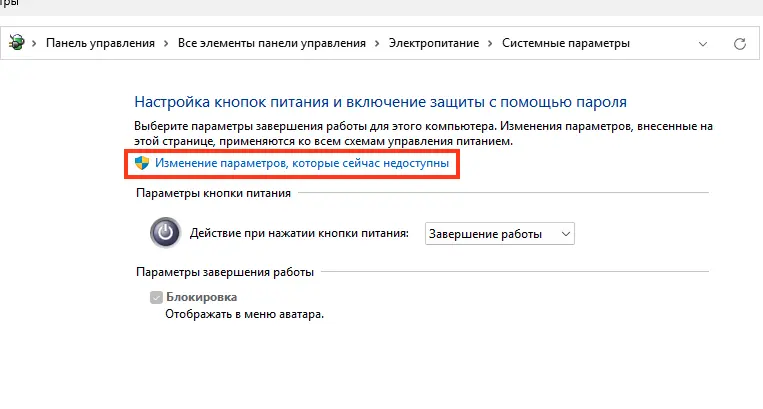
4. Снимите флажок Включить быстрый запуск (рекомендуется) (Turn on fast startup (recommended)).
5. Нажмите Сохранить изменения.
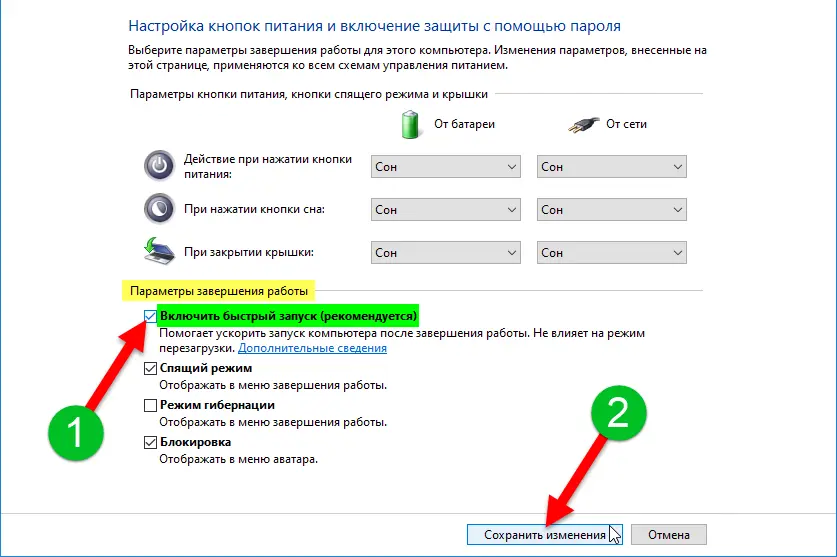
Шаг 4: Отправка Magic Packet
Magic Packet — это широковещательный UDP-пакет, содержащий MAC-адрес целевого устройства. Пакет отправляется на порт 7 или 9 (обычно UDP 9).
Узнайте MAC-адрес
Получите MAC-адрес сетевой карты:
Get-NetAdapter -Physical

Или:
ipconfig /all
Отправка Magic Packet через PowerShell
Используйте скрипт для отправки Magic Packet:
$Mac = "08:9e:01:6b:52:a2"
$MacByteArray = $Mac -split "[:-]" | ForEach-Object { [Byte] "0x$_"}
[Byte[]] $MagicPacket = (,0xFF * 6) + ($MacByteArray * 16)
$UdpClient = New-Object System.Net.Sockets.UdpClient
$UdpClient.Connect(([System.Net.IPAddress]::Broadcast), 7)
$UdpClient.Send($MagicPacket, $MagicPacket.Length)
$UdpClient.Close()
Замените $Mac на MAC-адрес целевого устройства.

Использование утилиты WakeMeOnLan
1. Скачайте WakeMeOnLan от NirSoft.
2. Запустите утилиту:
– Она автоматически сканирует сеть и отображает устройства.
– Или добавьте устройство вручную, указав IP или MAC-адрес.
3. Отправьте Magic Packet:
– По IP:
WakeMeOnLan.exe /wakeup 192.168.31.15
– По MAC:
WakeMeOnLan.exe /wakeup 08-9E-01-6B-52-A2
WoL с мобильных устройств
Используйте приложение, например, Wake On LAN для Android или iOS. Укажите MAC-адрес и IP устройства, подключившись к той же Wi-Fi-сети.
Настройка сети для WoL
– Локальная сеть: Убедитесь, что отправляющее устройство и целевой компьютер находятся в одной подсети.
– VLAN/разные подсети: Настройте маршрутизатор или коммутатор для пересылки широковещательных пакетов UDP 9 (например, через Directed Broadcast или WoL Relay).
– Брандмауэр: Windows Defender Firewall не требует открытия портов, так как Magic Packet обрабатывается сетевой картой напрямую.
Устранение неполадок
Компьютер не включается:
– Проверьте, включена ли WoL в BIOS/UEFI и сетевом адаптере.
– Убедитесь, что Быстрый запуск отключен.
– Проверьте состояние компьютера (должен быть в S3, S4 или S5).
Пакет не доходит:
– Убедитесь, что устройства в одной подсети.
– Проверьте настройки маршрутизатора для широковещательных пакетов.
– Wi-Fi адаптер: Для WoWLAN (Wake on Wireless LAN) убедитесь, что адаптер поддерживает эту функцию.
Настройка Wake-on-LAN в Windows 10 и Windows 11 включает активацию функции в BIOS/UEFI, настройку сетевого адаптера и отправку Magic Packet через PowerShell или утилиты, такие как WakeMeOnLan. Поддержка WoWLAN расширяет возможности для Wi-Fi. Правильная конфигурация сети и отключение Быстрого запуска обеспечивают надежную работу WoL, позволяя удаленно включать компьютер для удобного администрирования или доступа.
Quick Links
-
Why Use WoL and How It Works
-
Setting Up Your Wake Device
Wake-on-LAN (WoL) is an old-school technique that network administrators have used for years to remotely turn on PCs on the same network without sidling up to them. You can use it at home, too. Here’s how.
Why Use WoL and How It Works
First, let’s discuss why you might want to use this feature, and really there’s only one: convenience. Let’s say you’re making coffee in the kitchen, and you want the PC on by the time you get to your home office. Just fire up an app from your phone, tap a button, and your PC will be ready and waiting by the time you get there.
It doesn’t have to be just a phone that wakes your PC either. You can use this trick from another PC, a Mac, or even a smart speaker if you don’t mind a slightly complicated setup.
Wake-on-LAN’s basic premise is pretty simple. Computers send and receive information in small parts called packets. When WoL is enabled, your PC is waiting for a so-called «magic packet» that tells it to wake up by including the PC’s MAC address.
Remember that without some tweaking that is beyond the scope of this article, WoL is not a remote feature. Your waking device (the phone) has to be on the same network that the PC to be waked is using.
WoL Prerequisites
Before anything else, your PC needs to be on an Ethernet connection. For that reason, this trick works best with desktops or laptops that are always plugged into Ethernet. You may also have to turn Wi-Fi off on the target device for WoL to work properly.
Next, you need to have WoL enabled in your computer’s BIOS. We’ve got a tutorial on how to get into your PC’s BIOS as it’s slightly different depending on the brand. Usually, however, it’s a matter of hitting a dedicated key or a regular keyboard key such as Del.

Looking inside the BIOS the Wake-on-LAN option may be organized differently and the feature can be packaged as part of a larger set of features. On this example PC, the WoL feature was found under Power as its own entry. If you can’t find the feature, search for it on Google using your motherboard’s brand name and model number.
Often WoL is enabled automatically in the BIOS, but it’s always a good idea to double-check.
Next, you have to enable WoL inside Windows 10 or 11.
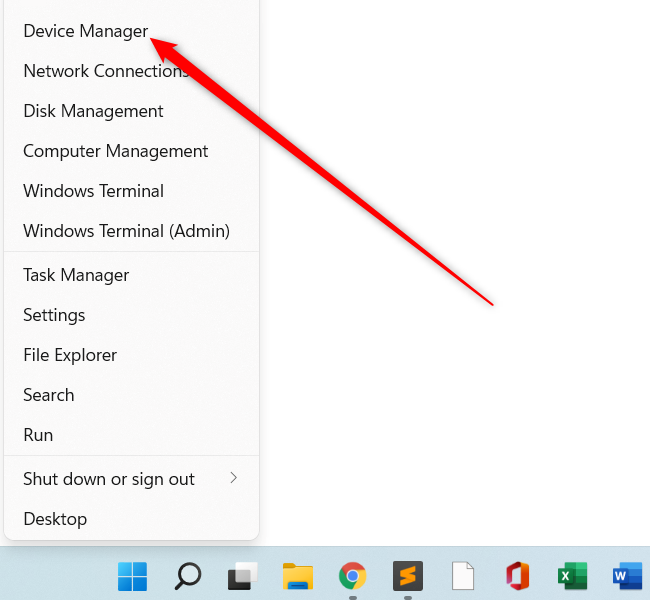
First, you need to open the Device Manager by right-clicking the start button and selecting «Device Manager.» Another alternative is to search for it by hitting the Start button and typing in «device manager.»
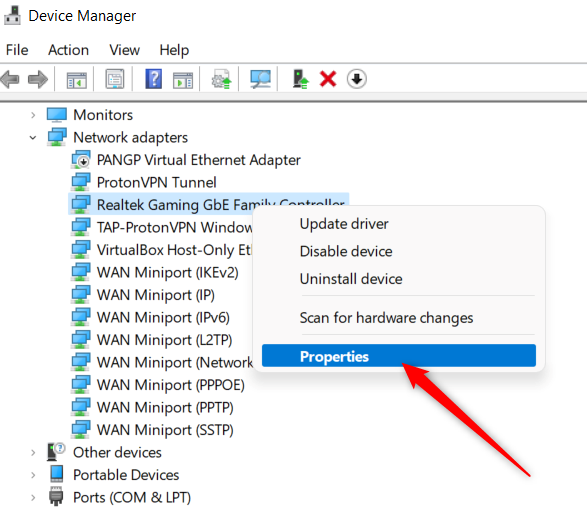
Once the utility opens click on Network adapters and select your Ethernet controller. You may have a ton of options, but you’re looking for something with a name that includes «controller,» «adapter,» or something similar. Anything that says TAP, VPN, or host-only is not what you’re looking for.
Once you’ve found your Ethernet controller right-click it and select Properties.
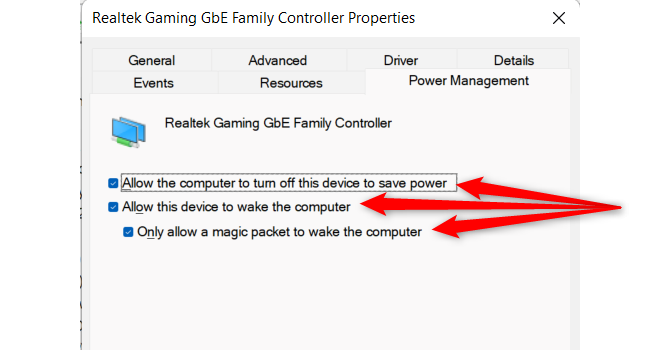
A properties window will open. Click the «Power Management» tab and make sure all three boxes there are checked including:
- Allow The Computer To Turn Off This Device To Save Power
- Allow This Device To Wake The Computer
- Only Allow A Magic Packet To Wake The Computer
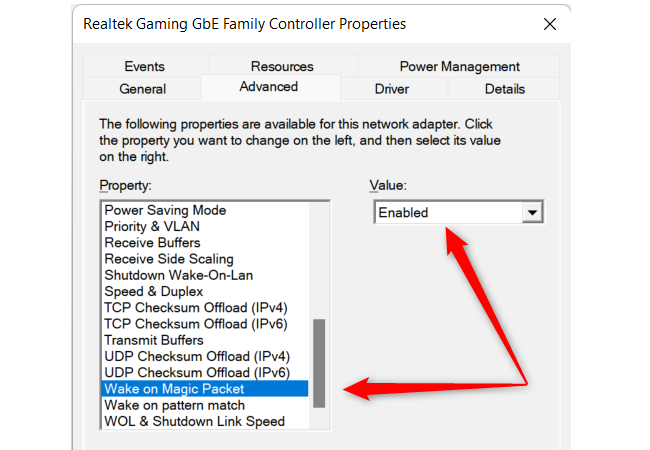
Before we close this window let’s go to the «Advanced» tab. In the list scroll down to «Wake On Magic Packet,» select it, and ensure under «Value» that the drop-down box says «Enabled.»
If that’s the case, click «OK,» and you’re done with this part.
One last thing: open the Settings app by hitting Windows+i on your keyboard. Then in Windows 11 go to Network & Internet > Ethernet, and scroll down to the bottom of the window.
In Windows 10 go to Network & Internet > Ethernet, and then at the top click on the name of your Ethernet connection. Next, scroll all the way down under «Properties.»
Here you’ll find something labeled «Physical address (MAC)» and then a combination of letters and numbers. It’s usually about 12 characters separated by dashes. Copy this down in case you need it.
Setting Up Your Wake Device
With the PC set up, it’s time to get our device ready that’s going to do the waking.
For this example, we’re going to make it nice and simple and use a phone. Download the Wake On Lan app from developer Mike Webb.
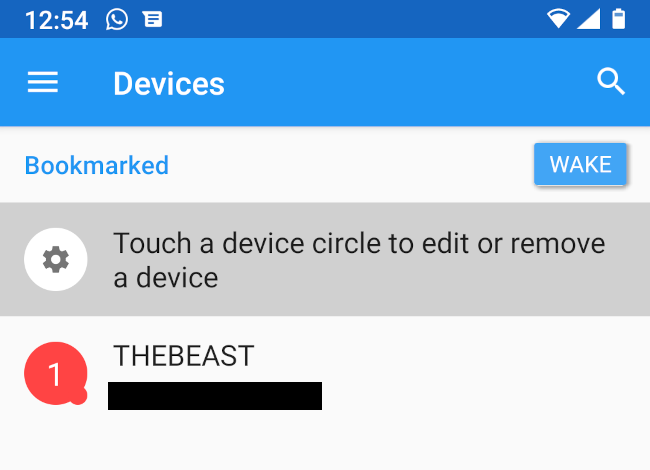
Once it’s installed, make sure you’re connected via Wi-Fi to the same network your target PC is on. Now tap the plus (+) button on the main screen, and then when you get to the next screen, pull down and wait. The pull-down will trigger a network search to find devices on your network.
Once you find your device, you can select it, and you’re done. If you don’t see it tap «Enter Manually,» give your device a nickname and enter its MAC Address. Then tap «Add Device.»
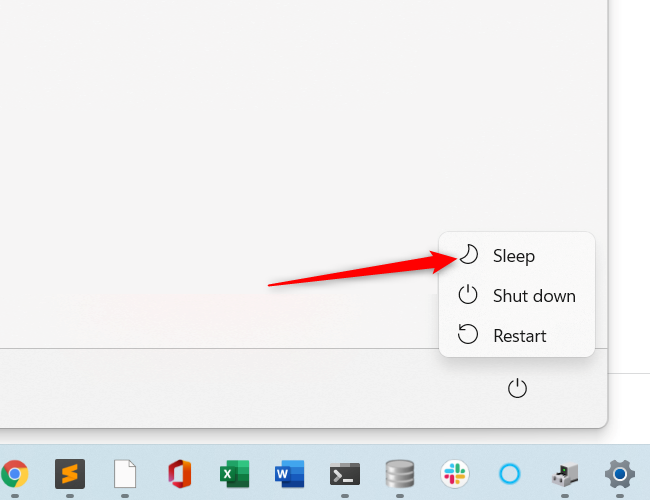
Now it’s time to test our setup. Go to your wakeable PC, click the Start menu, and then the power button. Instead of choosing, «Shut Down» choose «Sleep,» and wait for your PC to go into the low-power mode.
Now, open up the Wake-on-LAN app on your phone, tap your device, and it should turn on within a few seconds.
Troubleshooting
If the WoL feature doesn’t work do some basic troubleshooting such as making sure your PC is actually sleeping. Are all the RGB lights off (assuming you didn’t set them to remain on)? Is the power button glowing as if the PC is on? Try waking it the standard way to see what happens.
If the PC was truly asleep then check that your phone is connected to the right Wi-Fi network, put your PC back to sleep and try again. It may also be worth checking your Ethernet cable for faults.
Wake-on-LAN is a fun, easy feature to enable that can be very helpful for those times you want your PC to be ready to go the moment you are.

